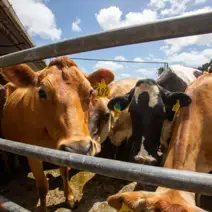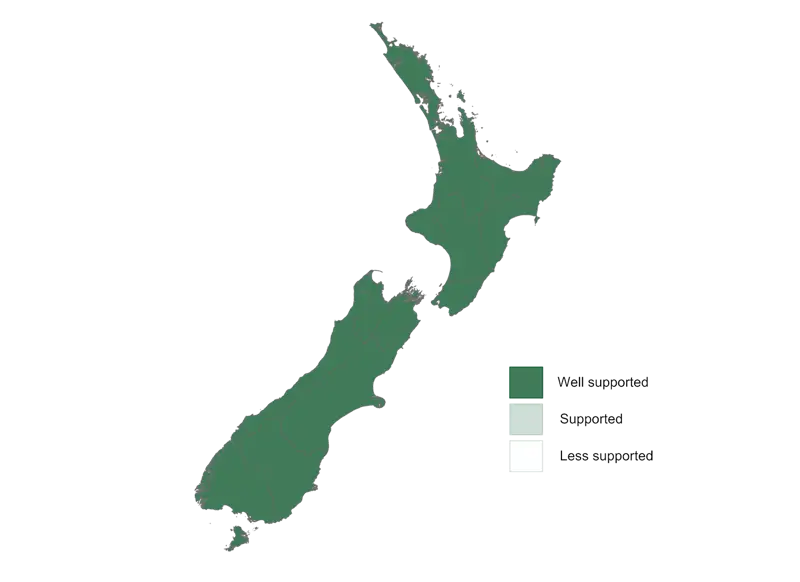
Land Use Fact Sheet
Dairy
Dairy farming is a profitable and popular farming choice in New Zealand. Advances in science and genetics mean that our dairy cows are highly productive, producing more milk with higher milk solids than in the past. Most dairy farms in New Zealand are found in the Waikato, Canterbury, Southland and Taranaki.
Most of the milk companies and cooperatives that supply milk in NZ have a limited supplier base – Fonterra is the biggest.
 Overview
Overview
Regions
Dairy farms are located all over New Zealand. There are no regions where dairy farming is not an option.
Growing conditions
Dairy farming uses flat to gently rolling land that can grow enough feed to sustain the animals. Most farms buy in feed too.
Climate
New Zealand’s temperate climate is perfect for growing the pasture and crop plants that are needed for dairy farming.
Commercial scale
The average size of a dairy farm in New Zealand is 153 ha. Many farmers lease at least some of their land from neighbours.
Getting started
New Zealand dairy farmers can be owner-operators, sharemilkers or contract milkers. You can also lease your land to a farmer.
Skills / employment
Running a dairy farm requires business skills as well as farming expertise. Most farmers take advice from expert consultants.
 Regions
Regions
Dairy farms are located all over New Zealand.
Get a report on your whenua
Enter the details of your whenua into our search to create a downloadable report showing information about the environment, economy, and climate in your region — and the potential that creates for development.

 Commercial scale
Commercial scale
The average size of a dairy farm in New Zealand is 153ha.
 Getting into the industry
Getting into the industry
A dairy farming business can be structured in several different ways. Converting to dairy requires detailed analysis, and substantial capital investment in things like:
- the milking shed and other buildings
- livestock
- company shares
- races
- fences
- water, and
- effluent management systems.
This will be specific to each business. For more information about dairy conversions see the resources section.
The main operating structures found on New Zealand dairy farms are owner operator, sharemilker and, to a lesser extent, contract milker.
- Owner operators are farmers who own and operate their own farms, or who employ a manager to operate the farm for a fixed wage. They receive all the income and pay all the costs.
- Contract milkers are contracted to milk a herd at a set price per kilogram of milk solids produced. The rate is set by negotiation and the amount of farm work done.
- Sharemilking involves operating a farm on behalf of the farm owner for an agreed share of the farm income. The most common forms of sharemilking agreements are variable order, and 50/50 or herd-owning sharemilking.
- Under a variable order agreement the farm owner often retains some involvement in the management of the farm. They retain ownership of the herd and bear more of the farm costs, like animal health and breeding.
- 50/50 sharemilkers own the herd and any plant and equipment (other than the milking plant) needed to farm the property.
 Skills and employment
Skills and employment
Managing and operating a dairy farm requires skill in both the business and technical aspects of farming. Dairy farmers need a strong team with experience in the industry to provide advice when required. This may include:
- farm consultants
- qualified accountants
- farm consultants, and
- technical field reps.
Staff may be needed on the farm, depending on the operating structure and the size of the business. Typical roles for farm staff include:
- strategy and business planning
- setting goals
- animal husbandry and stock management
- pasture management and grazing approaches
- crop management
- machinery operation, and
- team management.
 Compliance
Compliance
Dairy farms need to meet a wide range of compliance obligations. These include (but are not limited to):
- employment law
- health & safety
- taxes and financial record keeping
- animal welfare
- handling food products
- environmental regulations
- biosecurity
- milk supply regulations.
Some compliance regulations are set at a national level, and others are regional.
Regulations get updated over time, so it’s important to take qualified third-party advice to make sure you're aware of all your compliance obligations, and that you're meeting them.
Levies
Farmers need to pay:
- an industry good levy of 3.5c/kg of milk solids to industry body DairyNZ
- a meat levy, when stock are sent to the works, and
- a biosecurity levy, due to the mycoplasma bovis outbreak.
National policy statement for freshwater management (NPSFM)
The National Policy Statement for Freshwater 2020 gives local authorities direction on how they should manage freshwater under the Resource Management Act 1991. As such, some local authorities require growers and farmers to create a Farm Environment Plan (FEP). Make sure you're familiar with the FEP expectations in your region. Check with your local council about the requirements for your whenua or planned development.
Even if your region doesn't yet require an FEP, it's good practice to put one in place for your whenua as part of your business plan. The Foundation for Arable Research (FAR) provides templates you can use to create an FEP.
 Growing conditions
Growing conditions
Dairy farming requires land that can grow enough feed to sustain the animals, with most farms supplementing some feed and nitrogen during the season. The amount of feed your herd needs depends on the time of year.
Cows are in milk for an average of about 250 days a year. This means that paddocks are needed for cows in milk, calving, and winter feed. Land can be used:
- as part of the main farm around the milking shed and infrastructure, or
- as a support block that provides grazing for cows that aren’t in milk.
This is often the case for land blocks that are separated by distance from the main farm itself.
DairyNZ has defined 5 farm production systems you can use to support your planning and benchmarking.
 Climate
Climate
New Zealand has a temperate climate which favours the pasture and crop species grown here for dairy. Improvements in technology and irrigation have allowed dairying to expand into non-traditional dairying areas such as Canterbury, and has improved pasture and crops grown in drier areas of the country, like Northland.
 Water
Water
Each region has specific requirements around water takes and allocation, but as a rule:
- animals need access to clean, fresh water in all paddocks, and shelter from heat and weather conditions
- all permanent waterways need to be fenced to ensure animals are kept out
- nutrient management is critical for a dairy farm, to minimise the possible impact of fertilisers on water quality.
Some farms rely on rainfall as a water source for plants and crops to grow, while others have irrigation systems to increase their pasture and crops grown. Your Farm Environment Plan (FEP) will help ensure good management of the water and soils on your farm.
Talk to your regional council or dairy company rep for advice on creating your FEP. More information about managing waterways can be found on the Dairy NZ website, and the Foundation for Arable Research (FAR) provides templates you can use to create an FEP.
 Market
Market
The New Zealand dairy industry is an export-driven market. Our biggest market for dairy products is China. About 95% of all NZ milk products are exported as:
- whole and skim powders
- butter
- cheese, and
- baby formula.
 Future industry
Future industry
The dairy industry is constantly evolving and the future holds both opportunities and challenges. Continued improvements in genetics for both pasture and cows will:
- improve production and profitability
- reduce environmental impacts.
Challenges for the dairy industry include the changing regulations for environmental footprints (water quality and climate change). These changes will:
- increase costs to the business, and
- require farm system changes.
In some areas there may also be limits put on the development of new dairy farms. These changes may see some farmers leave the industry.
Maintaining a social licence to operate will be critical as consumer preferences drive changes to buying decisions. There are also alternatives to milk on the market that are gaining popularity among some consumers.
 Operational costs
Operational costs
DairyNZ has a national benchmarking system called DairyBase, where farmers can better understand their business by comparing them against others in their region on:
- production
- revenue
- costs, and
- operating profit.
 Grower returns
Grower returns
The majority of a dairy farm’s income comes from sales of milk solids (milkfat and protein). The rest comes from things like stock sales (culling cows and young stock) and other income, like dividends from Fonterra for example.
New Zealand exports around 95% of dairy production so returns to the farmer are highly dependent on global demand and prices set by foreign markets for whole milk powder.
Understanding the drivers of farm profitability requires knowledge of what makes a dairy farm successful, and making use of the range of critical farm, regional and national benchmarks available to the landowners and land managers. Successful farmers will have a clear understanding of how their farm has performed historically, and its current and future potential. They will know the key aspects of the business and how they’re positioned with respect to their peers for productivity, cost control and profitability.
This knowledge can also help farmers mitigate external challenges like an extended dry season, and ensure environmental impacts are minimised. They will make decisions early based on a set of data, information and experience and be well set up for what lies ahead.
 Seek advice
Seek advice
Seek advice early, before you invest in any design or development.
Talk to your local Te Puni Kōkiri office to see how they can support you through your decision-making process. They will be able to provide advice and find out whether your project qualifies for funding.
Talk to the industry organisation to see what support and resources they can offer to people thinking about dairy.
If possible, seek out advice from people who are involved in the dairy industry in your area as well as knowledgeable suppliers.
Talk to qualified consultants who are experienced in dairy farming and other land developments in your area. They will be able to provide detailed, impartial advice on what will (and won't) work on your whenua.
 About this fact sheet
About this fact sheet
This fact sheet provides general information to help start and inform conversations. It is not comprehensive enough to support detailed decision-making.
The information in this fact sheet has been contributed by AgFirst, DairyNZ and Te Puni Kōkiri kaimahi. Data that has not been credited in the body of the fact sheet has been sourced from StatsNZ or provided by the contributors.
You can provide feedback on the content on this or any fact sheet by emailing the us at TPKinfo@tpk.govt.nz